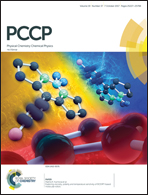Ab initio molecular dynamics of thiophene: the interplay of internal conversion and intersystem crossing†
Abstract
The fast and slow components of the relaxation of photoexcited thiophene have been investigated by means of SHARC (surface hopping including arbitrary couplings) molecular dynamics based on multiconfiguration electronic structure calculations. Triplet states are included to ascertain their role in the relaxation process. After thiophene is excited to the S1 state, ultrafast dynamics (τfast = 96 fs) initiates a ring opening due to cleavage of a carbon sulfur bond and simultaneous ring puckering. This time constant is in agreement with previous experimental and theoretical studies. The subsequent dynamics of the open-ring structures is characterized by the interplay of internal conversion and intersystem crossing. For the open-ring structures, the S0, S1, T1 and T2 states are nearly degenerate and the spin–orbit couplings are large. The underlying potential energy surface is flat and long-lived open-ring structures in the singlet as well as in the triplet states are formed. Both the participation of triplet states and the shape of the energy surface explain the experimentally observed slow ring closure in the ground state.



 Please wait while we load your content...
Please wait while we load your content...